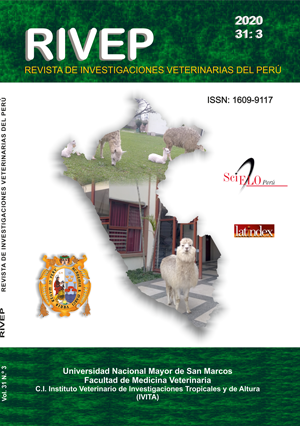Chemical castration in dogs by the intra-epididymal application of sclerosing substances
DOI:
https://doi.org/10.15381/rivep.v31i3.18155Keywords:
chemical castration, clorexidine, benzalkonium, cetrimide, dogsAbstract
The clinical effects, sperm parameters and macroscopic and histological lesions caused by chemical castration in dogs through the application of sclerosing substances were evaluated. Three groups were established: (G1, n=10), 4% chlorhexidine gluconate, (G2, n=10), 4% benzalkonium chloride + 0.4% cetrimide, and (G3, control, n=5) chloride of 0.9% sodium, at a dose of 0.5-1.0 ml intra-epididymal (IEPD) and bilateral on day 0. The effects were evaluated on days 2, 7, 14, 28 and 56 post-application. The manifest oligospermia was observed in 9/10 animals of G1 (90%) and in 7/10 of G2 at day 2 post-application, with a critical decrease of sperm concentration (3.78 ± 6.3 x 106/ml and 0.95 ± 0.89 x 106/ml, respectively, motility of 0.10 ± 0.32 - 0.20 ± 0.42% with oscillatory movement, without progressive advance and vitality of 0.30 ± 0.67% - 0% in both groups. Azoospermia was detected in all ejaculates of both groups from day 28, while sperm variables were normal in the dogs of the control group. The macro and microscopic changes were hydrocele, intra and extratubular haemorrhage, destruction and necrosis of the tubular wall, being more severe in G2, atrophy of the seminiferous tubules with replacement of fibrotic tissue, cysts and formation of spermiogranulomas from day 7 on G2 and G1. Chemical castration is considered an alternative for mass sterilization in dogs.
Downloads
Downloads
Published
Issue
Section
License
Copyright (c) 2020 José Goicochea Vargas, Yusepe Gomez Marín, Marcelo Ratto Fuster, Alfonso Chavera Castillo, Wilson Rondón Jorge, Fidel Acosta Pachorro, Carlos Ballarte Zevallos

This work is licensed under a Creative Commons Attribution-NonCommercial-ShareAlike 4.0 International License.
AUTHORS RETAIN THEIR RIGHTS:
a. Authors retain their trade mark rights and patent, and also on any process or procedure described in the article.
b. Authors retain their right to share, copy, distribute, perform and publicly communicate their article (eg, to place their article in an institutional repository or publish it in a book), with an acknowledgment of its initial publication in the Revista de Investigaciones Veterinarias del Perú (RIVEP).
c. Authors retain theirs right to make a subsequent publication of their work, to use the article or any part thereof (eg a compilation of his papers, lecture notes, thesis, or a book), always indicating the source of publication (the originator of the work, journal, volume, number and date).










